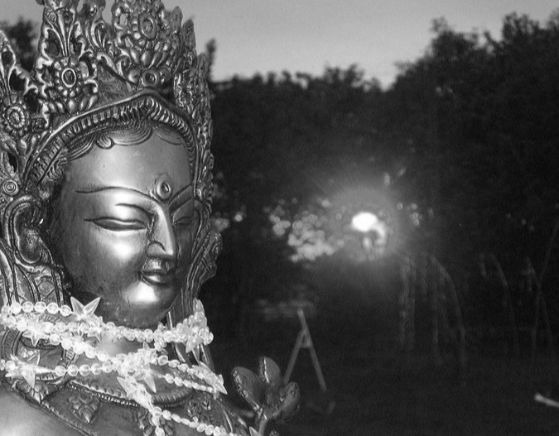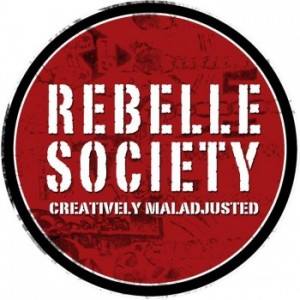Divine Mother: Mary, Tara, and That Virgin Business.

{source}
My relationship with the Divine Mother has always been that of a prodigal daughter.
Since I can remember, I have had a problem with the all-giving, all-forgiving archetype of the Divine Feminine that She has represented for about the last two millennia. I have always argued that that particular archetype of the Divine Feminine is nothing more than a figment of the immature imagination of some males who want their mommies to forgive them for being naughty boys.
In principle, there is nothing wrong with this except, of course, that in this archetype the woman has to be pure, and sexually pure at that,whatever the heck that means, which is, to say the least, unfair, dear gentlemen.
I love men, but I have zero time for patriarchy. So, before we move on to the main topic, I would like to say that sexual purity was never in vogue for women until some old patriarchs decided they needed their wives to be… well… virginal so that they would know whose child the woman was bearing. In earlier times, it was entirely up to the woman whose child she bore, as the family line started and ended with her.
Once we get over this little bump — no pun intended — we can all get along better, we can all enjoy our sexuality as a spiritual thing and feel empowered by it, rather than feeling guilty about it.
But back to the Divine Mother. You can imagine, as a young woman I was not terribly impressed by the image of a somewhat forced purity, as I fully intended to enjoy my sexuality, yet at the same time, I was spiritually inclined and did not see the spiritual/sexual divide that the old beliefs imposed on us.
It is also my belief that men are equally unhappy with the holy mother versus the sexy-but-naughty woman whom you do not marry if you want to please your mommy — an archetypal choice. In the Western tradition, of course, these two archetypes are represented by the Virgin Mary and Mary Magdalene.
In my book Jerusalem Diary, I even added a naughty rant against the virgin archetype, but these days I am more mildly inclined and, dare I say, wiser?
Since writing that book, I have done intense research on the archetype of the Divine Mother, and believe that the archetype has a lot to offer. First of all, I was surprised to learn that Carl Jung himself — that alchemist of the human psyche — was delighted when, in 1950, Pope Pius XII announced that the Virgin Mary had gone to heaven without ever dying, and in her body! Yep, a Pope can do that.
Jung was delighted because he said that finally in Western tradition, we had a true Goddess, and that it would be the beginning of the new rise of the Divine Feminine, and he was right!
As much as I am opposed to the whole virgin business, I have learned that Marguerite Rigoglioso, a feminist author, devoted an entire book to the theme of the virgin birth phenomenon.
In her book The Cult of Divine Birth, Rigoglioso writes that the story of the virgin birth is a prominent one in many spiritual traditions, such as those from Ancient Egypt and Greece, Ancient Persia, and in Judaic scriptures, to mention a few. They all tell the story of miraculous conception by an invisible higher being which results in the birth of a highly spiritually evolved child.
As imaginary as this might sound, there might also be something in Tantric and Gnostic traditions, where we find mention not of a virgin birth but of the importance of intention when conceiving a child. According to Tantric tradition, a great Tantric philosopher, aand Yogi, Abhinavagupta, was born with great spiritual gifts because his parents conceived him while in a heightened state of consciousness.
Similarly, the Gospel of Philip says that the spiritual intention of parents during conception creates a spiritually evolved, higher-level human.
But the most interesting claim by Rigoglioso is that ancient priestesses followed a set of rituals which actually allowed them to conceive without a man! I assume, through the invoking of some higher, multidimensional deity/being to enter them. I will leave it up to you as to what your thoughts are on that.
My favorite opinion comes from the ever-charming Andrew Harvey. In his book The Return of the Mother, he shares my suspicions about the virgin birth, and he argues that by imposing impossible standards of purity on Mary, we put her in a golden prison and are dampening the true force of the feminine that she represents. Mary, for Harvey, is Mother Mary — forget the virgin stuff.
Another great example of the Divine Mother archetype, but with a kick, comes from Tibetan Buddhism. Here comes Tara!
Tara, as Thubten Chodron writes in her book How to Free Your Mind: The Practice of Tara the Liberator, was like Mary — a historical figure known as Princess Yeshe Dawa. From an early age, Tara was moved by her altruistic impulse to save all sentient beings from suffering. She decided that in order to accomplish this, she needed to become enlightened.
The monks insisted that she had to wait until she was reincarnated as a man. But she told them she had no time for such nonsense, plus there were enough male Buddhas around. She wanted to accomplish her task in her female body. And the rest is, of course, history. Tara is the beloved archetype of the Divine Mother in Tibetan Buddhism.
She is often represented as a beautiful young woman standing on a white lotus flower, with one leg stepping out into the world of suffering and the other firmly grounded in the world of the Spirit.
I must admit that nowadays I am more friendly with the Divine Mother, especially so because Her incarnations, like Mary and Tara, bring compassion to our world.
They act as the bridge between the world of matter and the world of Spirit, and show us that the line between the two worlds is not as clearly defined as it seems, that enlightenment is possible for us all, and that we too are capable of healing the world through compassion instead of giving in to despair.
And it all has to do with acting on our altruistic impulses or, as Harvey says, checking what breaks our hearts, since the very thing that breaks your heart is the path to your service, to your way of healing the world.
What breaks your heart, my friends? Only your love for the world can heal this.
***
Dr. Joanna Kujawa is the author of Jerusalem Diary (a spiritual travelogue) and many short stories, essays and academic pieces. She sees herself as a Spiritual Detective who asks difficult questions about spirituality, such as ‘Can spirituality and sexuality be experienced as one?’, ‘Who was the real Mary Magdalene?’, ‘How can we include eco-spirituality in our belief systems?’ and ‘How can we bring back the Divine Feminine to create a more balanced and interconnected world?’ Her goal is to create and participate in the shift in consciousness about spirituality, our connection to nature, and our place in the Universe. She has PhD from Monash University, and MA and BA from the University of Toronto. She is immoderately passionate about her Goddess News blog. You could connect with her via her website, Facebook, Twitter or YouTube.
***
{Join us on Facebook, Twitter, Instagram & Pinterest}

